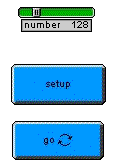|
What
is it?
|
|
This project
is inspired by the aggregation behavior of slime-mold cells.
It shows how creatures can aggregate into clusters using a
very decentralized strategy, without any "leader" involved.
In this example, each creature drops a chemical pheromone
(shown in green). The creatures also "sniff" ahead, trying
to follow the gradient of the chemical. Meanwhile, the patches
diffuse and evaporate the chemical. Following these simple,
decentralized rules, the creatures aggregate into clusters.
|
| How
to Use It |
|
Click
the setup button to set up a collection of slime-mold
cells. Click the go button to start the simulation.
The number slider controls the number of slime mold
cells. Changes in the slider do not have any effect
until the next setup command.
|
 |
|
| Things
to Notice |
|
With 100
creatures, not much happens. The creatures wander around,
dropping chemical. But the chemical evaporates and diffuses
fairly quickly, and the creatures do not aggregate. With 500
creatures, following the exact same rules, the result is qualitatively
different. When a few creatures happen (by chance) to wander
near one another, they create a "puddle" of chemical. The
creatures sniff the chemical and try to stay nearby. They
then deposit more chemical in the puddle, so the puddle expands
and attracts more creatures. This process is a good example
of positive feedback: the more creatures, the larger the puddle,
and the larger the puddle, the more likely it is to attract
more creatures.
|
| Explorations |
-
Modify the program so that the creatures aggregate into
a single large cluster more quickly.
- How
do the results change if there is more (or less) randomness
in the creatures' motion?
- What
"critical number" of creatures is needed for the clusters
to form? How does the critical number change if you modify
the evaporation or diffusion rate?
|
| StarLogo
Features |
| In the
uphill procedure, the turtle "follows the gradient" of the chemical.
That is, it "sniffs" in three directions, then turns in the
direction where the chemical is strongest. The uphill procedure
can be useful in many other projects. You might want to try
variants of the uphill procedure, changing the number and placement
of "turtle sniffs." |
We welcome your feedback and suggestions! Please
send us email.
|